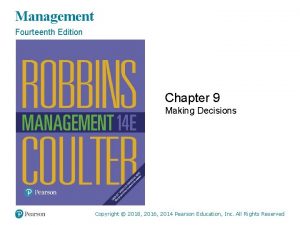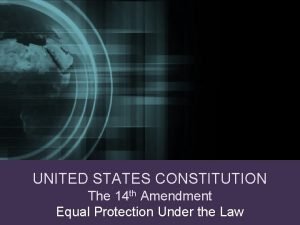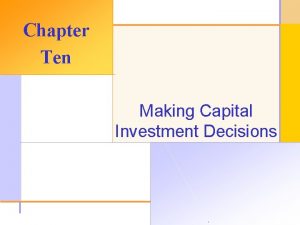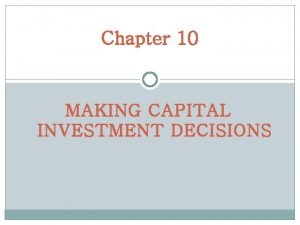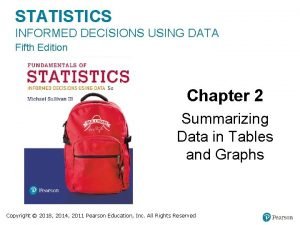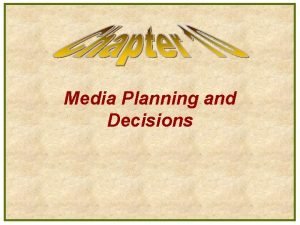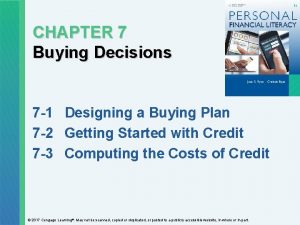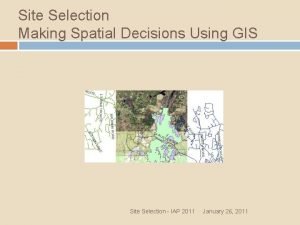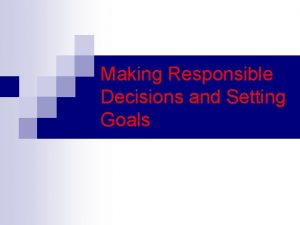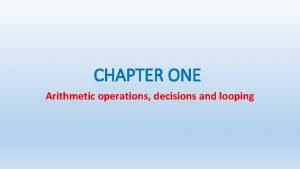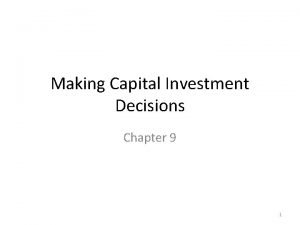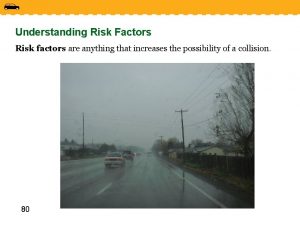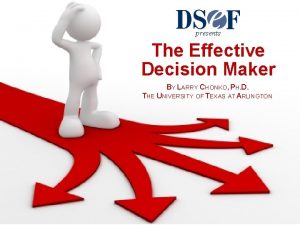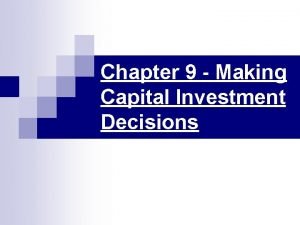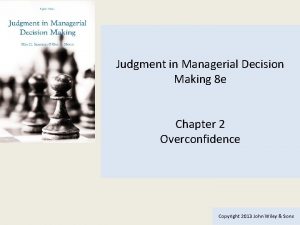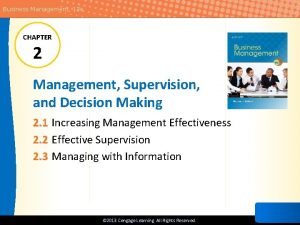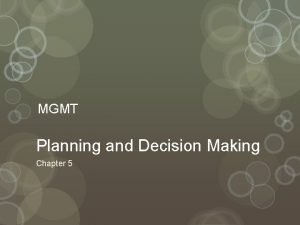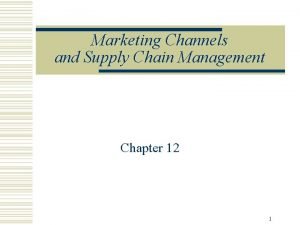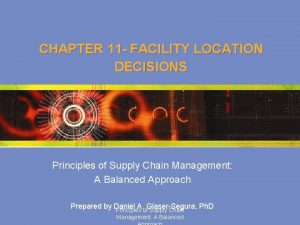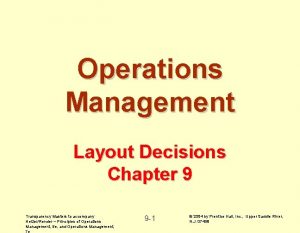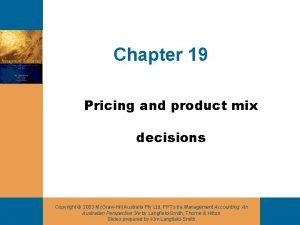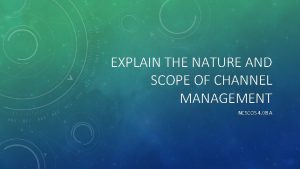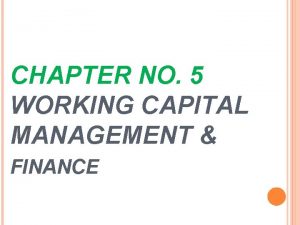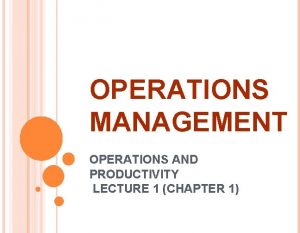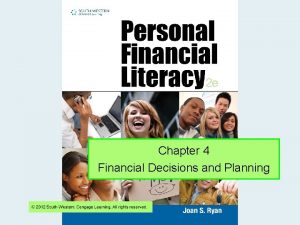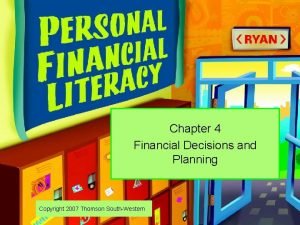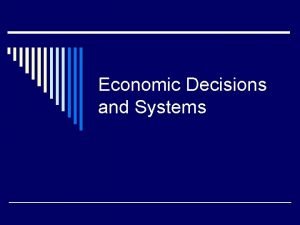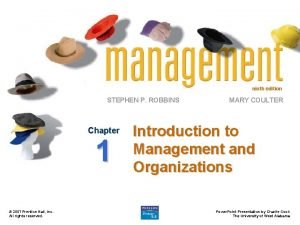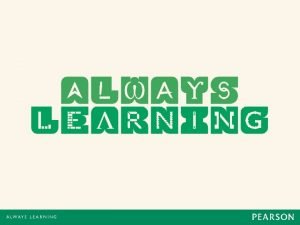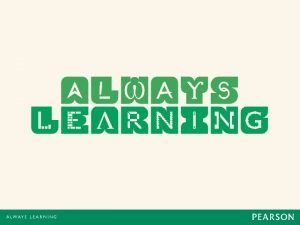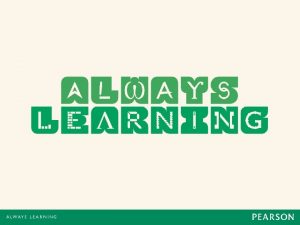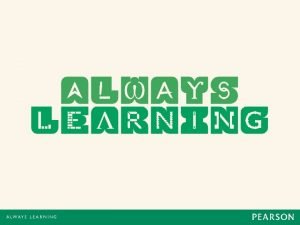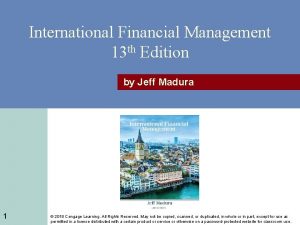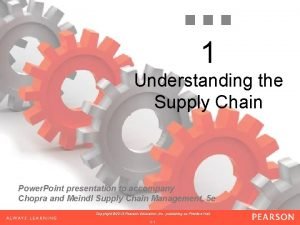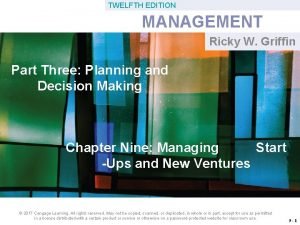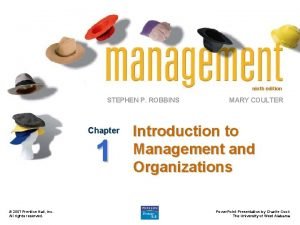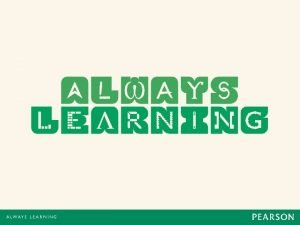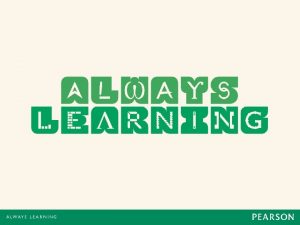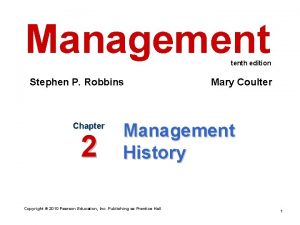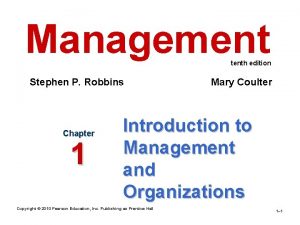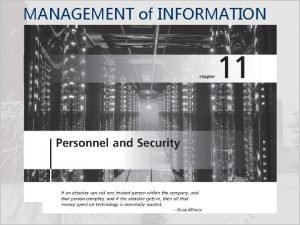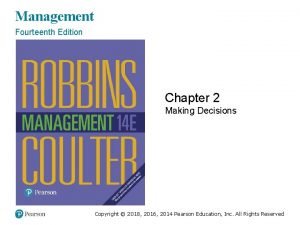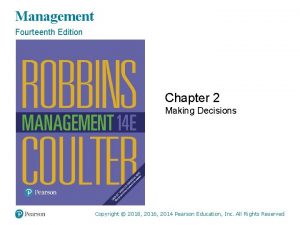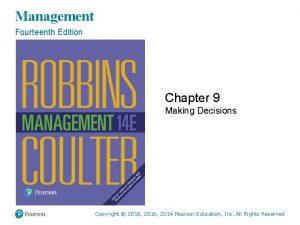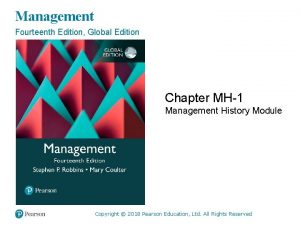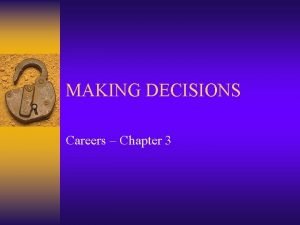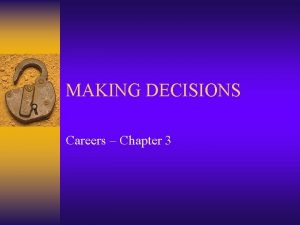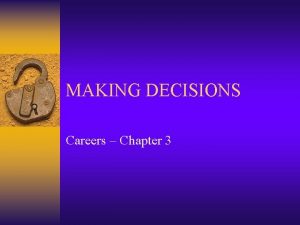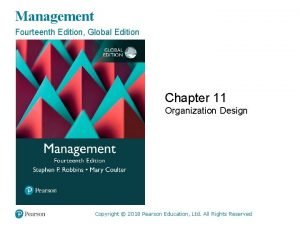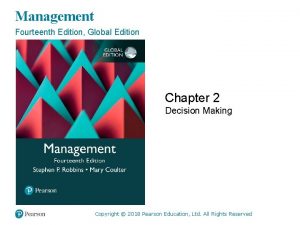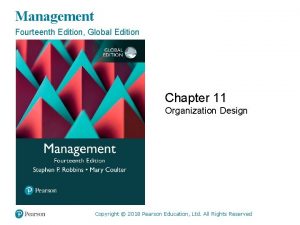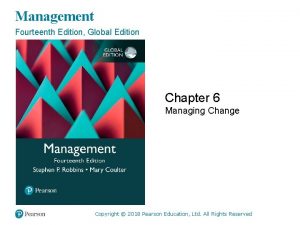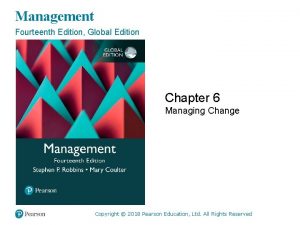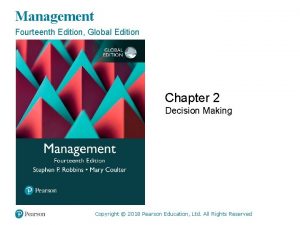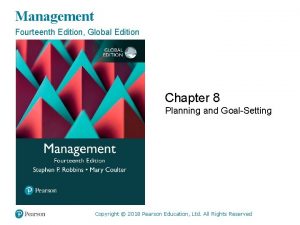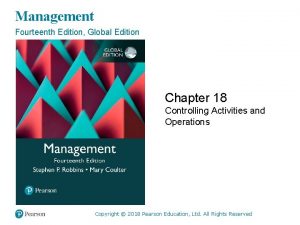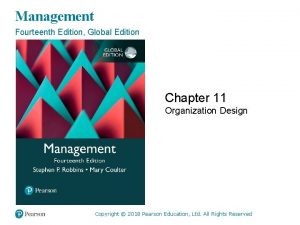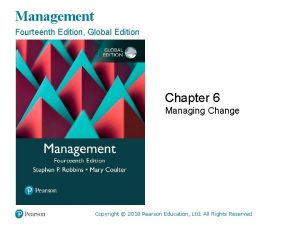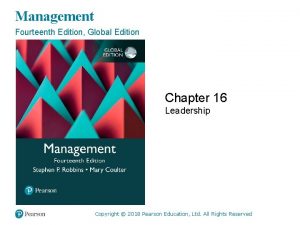Management Fourteenth Edition Chapter 2 Making Decisions Copyright








































































- Slides: 72

Management Fourteenth Edition Chapter 2 Making Decisions Copyright © 2018, 2016, 2014 Pearson Education, Inc. All Rights Reserved

Learning Objectives 2. 1 Describe the eight steps in the decision-making process. Develop your skill at being creative. 2. 2 Explain the four ways managers make decisions. 2. 3 Classify decisions and decision-making conditions. 2. 4 Describe how biases affect decision making. Know how to recognize when you’re using decisionmaking errors and biases and what to do about it 2. 5 Identify effective decision-making techniques. Copyright © 2018, 2016, 2014 Pearson Education, Inc. All Rights Reserved

Be A Better Decision-Maker A key to success in management and in your career is knowing how to be an effective decision-maker. Copyright © 2018, 2016, 2014 Pearson Education, Inc. All Rights Reserved

What is a Decision? Decision—a choice among two or more alternatives Copyright © 2018, 2016, 2014 Pearson Education, Inc. All Rights Reserved

Copyright © 2005 Prentice Hall, Inc. All rights reserved. Decision Making • Decision – Making a choice from two or more alternatives. • The Decision-Making Process – Identifying a problem and decision criteria and allocating weights to the criteria. – Developing, analyzing, and selecting an alternative that can resolve the problem. – Implementing the selected alternative. – Evaluating the decision’s effectiveness. 6– 5 Copyright © 2018, 2016, 2014 Pearson Education, Inc. All Rights Reserved

Exhibit 2 -1 Decision-Making Process Exhibit 2 -1 shows the eight steps in the decision-making process. This process is as relevant to personal decisions as it is to corporate decisions. Copyright © 2018, 2016, 2014 Pearson Education, Inc. All Rights Reserved

Decision-Making Process Step 1: Identify a Problem • Problem: an obstacle that makes it difficult to achieve a desired goal or purpose. • Every decision starts with a problem, a discrepancy between an existing and a desired condition. • Example: Amanda is a sales manager whose reps/ agents need new laptops. Copyright © 2018, 2016, 2014 Pearson Education, Inc. All Rights Reserved

Copyright © 2005 Prentice Hall, Inc. All rights reserved. Step 1: Identifying the Problem • Characteristics of Problems – A problem becomes a problem when a manager becomes aware of it. – There is pressure to solve the problem. – The manager must have the authority, information, or resources needed to solve the problem. 6– 8 Copyright © 2018, 2016, 2014 Pearson Education, Inc. All Rights Reserved

Decision-Making Process Step 2: Identify the Decision Criteria • Decision criteria are factors that are important to resolving the problem. • Example: Amanda decides that memory and storage capabilities, display quality, battery life, warranty, and carrying weight are the relevant criteria in her decision Copyright © 2018, 2016, 2014 Pearson Education, Inc. All Rights Reserved

Copyright © 2005 Prentice Hall, Inc. All rights reserved. Step 2: Identifying Decision Criteria • Decision criteria are factors that are important (relevant) to resolving the problem. E. g. : – Costs that will be incurred (investments required) – Risks likely to be encountered (chance of failure) – Outcomes that are desired (growth of the firm) 6– 10 Copyright © 2018, 2016, 2014 Pearson Education, Inc. All Rights Reserved

Decision-Making Process Step 3: Allocate Weights to the Criteria • If the relevant criteria aren’t equally important, the decision maker must weight the items in order to give them the correct priority in the decision. • Example: The weighted criteria for Amanda’s computer purchase are shown in Exhibit 2 -2. Copyright © 2018, 2016, 2014 Pearson Education, Inc. All Rights Reserved

Decision-Making Process Step 3: Allocate Weights to the Criteria • How? A simple way is to give the most important criterion a weight of 10 and then assign weights to the rest using that standard. Of course, you could use any number as the highest weight. The weighted criteria for our example is shown in Exhibit 2 -2. Copyright © 2018, 2016, 2014 Pearson Education, Inc. All Rights Reserved

Exhibit 2 -2 Important Decision Criteria Criterion Weight Memory and storage 10 Battery life 8 Carrying weight 6 Warranty 4 Display quality 3 Copyright © 2018, 2016, 2014 Pearson Education, Inc. All Rights Reserved

Decision-Making Process Step 4: Develop Alternatives • List viable alternatives that could solve the problem. • Example: Amanda identifies eight laptops as possible choices (shown in Exhibit 2 -3). • decision maker needs to be creative, and the alternatives are only listed— not evaluated Copyright © 2018, 2016, 2014 Pearson Education, Inc. All Rights Reserved

Exhibit 2 -3 Possible Alternatives Laptop Memory and Storage Battery Life Carrying Weight Warranty Display Quality 10 3 10 8 5 Lenovo Idea. Pad 8 5 7 10 10 Apple Mac. Book 8 7 7 8 7 Toshiba Satellite 7 8 7 Apple Mac. Book Air 8 3 6 10 8 10 7 8 6 7 4 10 4 8 10 HP Pro. Book Dell Inspirion HP Pavilion Copyright © 2018, 2016, 2014 Pearson Education, Inc. All Rights Reserved

Decision-Making Process Step 6: Select an Alternative • Choose the alternative that generates the highest total in Step 5. • In our example (Exhibit 2 -4), Amanda would choose the Dell Inspiron because it scored higher than all other alternatives (249 total). Copyright © 2018, 2016, 2014 Pearson Education, Inc. All Rights Reserved

Exhibit 2 -4 Evaluation of Alternatives Laptop Memory and Storage Battery Life Carrying Weight Warranty Display Quality Total 100 24 60 32 15 231 Lenovo Idea. Pad 80 40 42 40 30 232 Apple Mac. Book 80 56 42 32 21 231 Toshiba Satellite 70 64 42 32 21 229 Apple Mac. Book Air 80 24 36 40 24 204 100 56 48 24 21 249 40 80 24 32 30 206 HP Pro. Book Dell Inspirion HP Pavilion Copyright © 2018, 2016, 2014 Pearson Education, Inc. All Rights Reserved

Decision-Making Process Step 7: Implement the Alternative • Put the chosen alternative into action. • By Conveying the decision to those affected and get their commitment to it. • We know that if the people who must implement a decision participate in the process, they’re more likely to support it. Copyright © 2018, 2016, 2014 Pearson Education, Inc. All Rights Reserved

Decision-Making Process Step 7: Implement the Alternative • Another thing managers may need to do during implementation is reassess the environment for any changes, especially if it’s a longterm decision. Copyright © 2018, 2016, 2014 Pearson Education, Inc. All Rights Reserved

Decision-Making Process Step 8: Evaluate Decision Effectiveness • Evaluate the result or outcome of the decision to see if the problem was resolved. • If it wasn’t resolved, what went wrong? • Was the problem incorrectly defined? Were errors made when evaluating alternatives? Was the right alternative selected but poorly implemented? The answers might lead you to redo an earlier step or might even require starting the whole process over. Copyright © 2018, 2016, 2014 Pearson Education, Inc. All Rights Reserved

Group work Copyright © 2005 Prentice Hall, Inc. All rights reserved. • I need to buy a car. • The important criteria was: • price 10 • Security 8 • Economy 6 • Warranty 4 • Think as a team and decide which car you choose. 6– 21 Copyright © 2018, 2016, 2014 Pearson Education, Inc. All Rights Reserved

Exhibit 2 -5 Decisions Managers May Make: Planning and Organizing Copyright © 2018, 2016, 2014 Pearson Education, Inc. All Rights Reserved

Exhibit 2 -5 Decisions Managers May Make: Leading and Controlling Copyright © 2018, 2016, 2014 Pearson Education, Inc. All Rights Reserved

Rationality • Rational Decision-Making: choices that are logical and consistent and maximize value • Assumptions of rationality: – Rational decision maker is logical and objective – Problem faced is clear and unambiguous – Decision maker would have clear, specific goal and be aware of all alternatives and consequences – The alternative that maximizes achieving this goal will be selected – Decisions are made in the best interest of the organization Copyright © 2018, 2016, 2014 Pearson Education, Inc. All Rights Reserved

Copyright © 2005 Prentice Hall, Inc. All rights reserved. Assumptions of Rationality 6– 25 Exhibit 6. 6 Copyright © 2018, 2016, 2014 Pearson Education, Inc. All Rights Reserved

Making Decisions (cont’d) Copyright © 2005 Prentice Hall, Inc. All rights reserved. • Bounded Rationality – Managers make decisions rationally, but are limited (bounded) by their ability to process information. – Assumptions are that decision makers: § Will not seek out or have knowledge of all alternatives 6– 26 § Will satisfice—choose the first alternative encountered that satisfactorily solves the problem—rather than maximize the outcome of their decision by considering all alternatives and choosing the best. Copyright © 2018, 2016, 2014 Pearson Education, Inc. All Rights Reserved

Influences on Decision Making Copyright © 2005 Prentice Hall, Inc. All rights reserved. • Escalation of Commitment – Increasing or continuing a commitment to previous decision despite mounting evidence that the decision may have been wrong. E. g. , positive experience in dealing with some suppliers, currently suffers bad financial performance. strongly influenced by the organization’s culture, internal politics, power considerations. • The Role of Intuition – Intuitive decision making 6– 27 Copyright © 2018, 2016, 2014 Pearson Education, Inc. All Rights Reserved

Intuition • Intuitive decision-making: making decisions on the basis of experience, feelings, and accumulated judgment Copyright © 2018, 2016, 2014 Pearson Education, Inc. All Rights Reserved

Exhibit 2 -6 What is Intuition? Exhibit 2 -6 shows the five different aspects of intuition identified by researchers studying managers’ use of intuitive decision-making. Copyright © 2018, 2016, 2014 Pearson Education, Inc. All Rights Reserved

Evidence-Based Management • Evidence-based management (EBMgt): the systematic use of the best available evidence to improve management practice. • Any decision-making process is likely to be enhanced through the use of relevant and reliable evidence Copyright © 2018, 2016, 2014 Pearson Education, Inc. All Rights Reserved

Problems and Decisions Copyright © 2005 Prentice Hall, Inc. All rights reserved. • Structured Problems – Involve goals that clear. – Are familiar (have occurred before). – Are easily and completely defined—information about the problem is available and complete. • Programmed Decision – A repetitive decision that can be handled by a routine approach. – E. g. , registration process at IUG. 6– 31 Copyright © 2018, 2016, 2014 Pearson Education, Inc. All Rights Reserved

Copyright © 2005 Prentice Hall, Inc. All rights reserved. Types of Programmed Decisions • A Policy – A general guideline for making a decision about a structured problem. (system) – E. g. , Accept all customer-returned merchandise. – Students have the right to review his final mark. – The recruitment must start from job vacancy announcement. 6– 32 Copyright © 2018, 2016, 2014 Pearson Education, Inc. All Rights Reserved

Types of Programmed Decisions • A Procedure Copyright © 2005 Prentice Hall, Inc. All rights reserved. – A series of interrelated steps that a manager can use to respond (applying a policy) to a structured problem. – E. g. , Follow all steps for completing merchandise return documentation. – Purchasing procedures. – Follow the steps for reviewing marks. – Recruitment procedures. – Registration procedures. 6– 33 Copyright © 2018, 2016, 2014 Pearson Education, Inc. All Rights Reserved

Copyright © 2005 Prentice Hall, Inc. All rights reserved. Types of Programmed Decisions • A Rule – An explicit statement that limits what a manager or employee can or cannot do in carrying out the steps involved in a procedure. Examples: – Managers must approve all refunds over $50. 00. – No credit purchases are refunded for cash. – Reviewing marks can be within the first week of publishing final results. 6– 34 Copyright © 2018, 2016, 2014 Pearson Education, Inc. All Rights Reserved

Copyright © 2005 Prentice Hall, Inc. All rights reserved. Problems and Decisions (cont’d) • Unstructured Problems – Problems that are new or unusual and for which information is ambiguous or incomplete. – Problems that will require custom-made solutions. • Non-programmed Decisions – Decisions that are unique and nonrecurring/ infrequent. – Decisions that generate unique responses. – E. g. , making a decision regarding opening a second branch in a new geographical area. – few decisions in the real world are either fully programmed or non-programmed 6– 35 Copyright © 2018, 2016, 2014 Pearson Education, Inc. All Rights Reserved

Copyright © 2005 Prentice Hall, Inc. All rights reserved. Types of Problems, Types of Decisions, and Level in the Organization 6– 36 Exhibit 6. 8 Copyright © 2018, 2016, 2014 Pearson Education, Inc. All Rights Reserved

Exhibit 2 -7 Programmed vs Nonprogrammed Decisions Characteristic Programmed Decisions Nonprogrammed Decisions Type of problem Structured Unstructured Managerial level Lower levels Upper levels Frequency Repetitive, routine New, unusual Information Readily available Ambiguous or incomplete Goals Clear, specific Vague Time frame for solution Short Relatively long Solution relies on… Procedures, rules, policies Judgment and creativity Copyright © 2018, 2016, 2014 Pearson Education, Inc. All Rights Reserved

Decision-Making Conditions • Certainty: a situation in which a manager can make accurate decisions because all outcomes are known. E. g. , putting a deposit in a bank, the annual return on it is known. • Risk: a situation in which the decision maker is able to estimate the likelihood of certain outcomes • Uncertainty: a situation in which a decision maker has neither certainty nor reasonable probability estimates available Copyright © 2018, 2016, 2014 Pearson Education, Inc. All Rights Reserved

Managing Risk • Managers can use historical data or secondary information to assign probabilities to different alternatives • This is used to calculate expected value—the expected return from each possible outcome—by multiplying expected revenue by the probability of each alternative Copyright © 2018, 2016, 2014 Pearson Education, Inc. All Rights Reserved

Exhibit 2 -8 Expected Value Event Expected Revenues Probability Expected Value of Each Alternative Heavy snowfall $850, 000 0. 3 $255, 000 Normal snowfall $725, 000 0. 5 $362, 000 Light snowfall $350, 000 0. 2 $70, 000 Blank Total expected revenue: $687, 500 For each Event in the table, Expected Revenues multiplied by Probability gives the Expected Value of Each Alternative. Copyright © 2018, 2016, 2014 Pearson Education, Inc. All Rights Reserved

Decision-Making Conditions – Uncertainty is a situation in which the decision maker has neither certainty nor reasonable probability estimates available. – a. The choice of alternative is influenced by the limited amount of information available. – b. It’s also influenced by the psychological orientation of the decision maker. – 1) An optimistic manager will follow a maximax choice (maximizing the maximum possible payoff). – 2) A pessimistic one will pursue a maximin choice (maximizing the minimum possible payoff). – 3) The manager who desires to minimize the maximum regret will opt for a minimax choice/regret. © Prentice Hall, 2002 Prof. Dr. Majed El-Farra 6 -41 Copyright © 2018, 2016, 2014 Pearson Education, Inc. All Rights Reserved 41

Decision-Making Conditions Copyright © 2005 Prentice Hall, Inc. All rights reserved. • Uncertainty – Limited of information prevents estimation of outcome probabilities for alternatives associated with the problem and may force managers to rely on intuition, hunches, and “gut feelings”. § Maximax: the optimistic manager’s choice to maximize the maximum payoff. E. g. , S 4= § Maximin: the pessimistic manager’s choice to maximize the minimum payoff. E. g. , S 3= § Minimax: the manager’s choice to minimize his maximum regret. E. g. , S 4= 6– 42 Copyright © 2018, 2016, 2014 Pearson Education, Inc. All Rights Reserved

Exhibit 2 -9 Payoff Matrix Visa Marketing Strategy (in millions of dollars Master. Card CA 1 Master. Card CA 2 Master. Card CA 3 Strategy 1 13 14 11 Strategy 2 9 15 18 Strategy 3 24 21 15 Strategy 4 18 14 28 Exhibit 2 -9 shows the various Visa strategies and the resulting profit, depending on the competitive action (CA) used by Master. Card. Copyright © 2018, 2016, 2014 Pearson Education, Inc. All Rights Reserved

Exhibit 2 -10 Regret Matrix Visa Marketing Strategy (in millions of dollars Master. Card CA 1 Master. Card CA 2 Master. Card CA 3 Strategy 1 11 7 17 Strategy 2 15 6 10 Strategy 3 0 0 13 Strategy 4 6 7 0 Exhibit 2 -10 shows the regret for each category, which is found by subtracting all possible payoffs in each category from the maximum possible payoff for each given event, in this case for each competitive action. Copyright © 2018, 2016, 2014 Pearson Education, Inc. All Rights Reserved

Copyright © 2005 Prentice Hall, Inc. All rights reserved. EXERCISE • I need to establish a hotel in Gaza. The income depends on political and economic situation. There is a competition. The estimated annual income. Revenue in millions US$ Types of strategies cmption 1 1 2 4 6 2 4 5 2 3 1 3 4 4 3 6 10 6– 45 Copyright © 2018, 2016, 2014 Pearson Education, Inc. All Rights Reserved

Heuristics • Heuristics or “rules of thumb” can help make sense of complex, uncertain, or ambiguous information. • However, they can also lead to errors and biases in processing and evaluating information. Copyright © 2018, 2016, 2014 Pearson Education, Inc. All Rights Reserved

Exhibit 2 -11 Common Decision-Making Biases Exhibit 2 -11 identifies 12 common decision errors of managers and biases they may have. Copyright © 2018, 2016, 2014 Pearson Education, Inc. All Rights Reserved

Copyright © 2005 Prentice Hall, Inc. All rights reserved. Decision-Making Biases and Errors • Heuristics/ trial and error method – Using “rules of thumb” to simplify decision making. Base on past experience (trial and error method). • Overconfidence Bias – Holding unrealistically positive views of one’s self and one’s performance. • Immediate Gratification Bias/ short term thinking) – Choosing alternatives that offer immediate rewards and that to avoid immediate costs. 6– 48 Copyright © 2018, 2016, 2014 Pearson Education, Inc. All Rights Reserved

Copyright © 2005 Prentice Hall, Inc. All rights reserved. Decision-Making Biases and Errors (cont’d) • Anchor/ strongly linked – Fixating on initial information and ignoring subsequent information. • Selective Perception – Selecting organizing and interpreting events based on the decision maker’s biased perceptions. E. g. , first impression about price, impression about new investment. 6– 49 • Confirmation Bias – Seeking out information that reaffirms past choices and discounting contradictory information. Copyright © 2018, 2016, 2014 Pearson Education, Inc. All Rights Reserved

Copyright © 2005 Prentice Hall, Inc. All rights reserved. Decision-Making Biases and Errors (cont’d) • Framing Bias – Selecting and highlighting certain aspects of a situation while ignoring other aspects. E. g. , focus on revenue and ignore maintenance skills. • Availability Bias – Losing decision-making objectivity by focusing on the most recent events. 6– 50 Copyright © 2018, 2016, 2014 Pearson Education, Inc. All Rights Reserved

Copyright © 2005 Prentice Hall, Inc. All rights reserved. Decision-Making Biases and Errors (cont’d) • Representation Bias – Drawing analogies/likeness and seeing identical situations when none exist. E. g. , considers last summer revenue the same for this year. • Randomness Bias – Creating unfounded meaning out of random events. E. g. , event happened by chance. E. g. , making high profit because of having high stock of paints and Israel prevented paints from entry. 6– 51 Copyright © 2018, 2016, 2014 Pearson Education, Inc. All Rights Reserved

Copyright © 2005 Prentice Hall, Inc. All rights reserved. Decision-Making Biases and Errors (cont’d) • Sunk Costs Errors – Forgetting that current actions cannot correct past events and relate only to future consequences. • Self-Serving Bias – Taking quick credit for successes and blaming outside factors for failures. 6– 52 Copyright © 2018, 2016, 2014 Pearson Education, Inc. All Rights Reserved

Copyright © 2005 Prentice Hall, Inc. All rights reserved. Decision-Making Biases and Errors (cont’d) • Hindsight/observation Bias – Mistakenly believing that an event could have been predicted once the actual outcome is known (after-thefact). E. g. , let us start producing and will see the customer reaction. 6– 53 Copyright © 2018, 2016, 2014 Pearson Education, Inc. All Rights Reserved

Exhibit 2 -12 Overview of Managerial Decision Making Exhibit 2 -12 provides an overview of managerial decision making. Copyright © 2018, 2016, 2014 Pearson Education, Inc. All Rights Reserved

Guidelines for Making Effective Decisions • Understand cultural differences • Create standards for good decision making • Know when it’s time to call it quits • Use an effective decision-making process • Develop your ability to think clearly Copyright © 2018, 2016, 2014 Pearson Education, Inc. All Rights Reserved

Characteristics of an Effective Decision. Making Process • Focuses on what’s important • Is logical and consistent • Acknowledges subjective and analytical thinking, blends analytical with intuitive thinking • Requires only as much information as is needed to resolve particular dilemma • Encourages the gathering of relevant information • Is straightforward, reliable, easy-to-use, flexible Copyright © 2018, 2016, 2014 Pearson Education, Inc. All Rights Reserved

Design Thinking and Decision Making • Design thinking: approaching management problems as designers approach design problems Copyright © 2018, 2016, 2014 Pearson Education, Inc. All Rights Reserved

Big Data and Decision-Making • Big data: the vast amount of quantifiable data that can be analyzed by highly sophisticated data processing • Can be a powerful tool in decision making, but collecting and analyzing data for data’s sake is wasted effort Copyright © 2018, 2016, 2014 Pearson Education, Inc. All Rights Reserved

Linear-Nonlinear thinking style Copyright © 2005 Prentice Hall, Inc. All rights reserved. • Thinking style reflects two things: • 1 - source of information used: external data or internal, such as intuition. • 2 - how he process that information: • (linear- rational, logic and analytic; or nonlinearintuitive and creative. • - linear thinking style: prefer use external data and process it through rational and logic. • - nonlinear style: prefer use internal source of information and process it by intuition. 6– 59 Copyright © 2018, 2016, 2014 Pearson Education, Inc. All Rights Reserved

Copyright © 2005 Prentice Hall, Inc. All rights reserved. Decision-Making Styles • Dimensions of Decision-Making Styles – Ways of thinking § Rational, orderly, and consistent § Intuitive, creative, and unique – Tolerance for ambiguity § Low tolerance: require consistency and order § High tolerance: multiple thoughts simultaneously 6– 60 Copyright © 2018, 2016, 2014 Pearson Education, Inc. All Rights Reserved

Copyright © 2005 Prentice Hall, Inc. All rights reserved. Decision-Making Styles 6– 61 Source: S. P. Robbins and D. A. De. Cenzo, Supervision Today. 2 nd ed. (Upper Saddle River, NJ: Prentice Hall, 1998). p. 166. Exhibit 6. 12 Copyright © 2018, 2016, 2014 Pearson Education, Inc. All Rights Reserved

Decision-Making Styles (cont’d) 6– 62 Copyright © 2005 Prentice Hall, Inc. All rights reserved. • Types of Decision Makers – Directive: Use minimal information and consider few alternatives. E. g. , buying a Chinese I-bad. – Analytic: Make careful decisions in unique situations, few alternatives. E. g. , Developing a program for purchasing and warehousing. – Conceptual: Maintain a broad outlook and consider many alternatives in making longterm decisions. E. g. , Deciding of opening a small business. – Behavioral: Avoid conflict by working well with others and being receptive/open to suggestions. Copyright © 2018, 2016, 2014 Pearson Education, Inc. All Rights Reserved

Types of Decision Makers Copyright © 2005 Prentice Hall, Inc. All rights reserved. • Most managers realistically probably have a dominant style and alternate styles, • with some relying almost exclusively on their dominant style and others being more flexible depending on the situation. 6– 63 Copyright © 2018, 2016, 2014 Pearson Education, Inc. All Rights Reserved

Review Learning Objective 2. 1 • Describe the eight steps in the decisionmaking process. – – – – 1. Identify problem 2. Identify decision criteria 3. Weight the criteria 4. Develop alternatives 5. Analyze alternatives 6. Select alternative 7. Implement alternative 8. Evaluate decision effectiveness Copyright © 2018, 2016, 2014 Pearson Education, Inc. All Rights Reserved

Review Learning Objective 2. 2 (1 of 2) • Explain the four ways managers make decisions. – Assumptions of rationality § The problem is clear and unambiguous § A single, well-defined goal is to be achieved § All alternatives and consequences are known § The final choice will maximize the payoff Copyright © 2018, 2016, 2014 Pearson Education, Inc. All Rights Reserved

Review Learning Objective 2. 2 (2 of 2) • Satisficing: when decision makers accept solutions that are good enough • Escalation of commitment: managers increase commitment to a decision, even when they have evidence it may have been a wrong decision • Intuitive decision making: making decisions on the basis of experience, feelings, and accumulated judgment • Evidence-based management: a manager makes decisions based on the best available evidence Copyright © 2018, 2016, 2014 Pearson Education, Inc. All Rights Reserved

Review Learning Objective 2. 3 (1 of 2) • Classify decisions and decision-making conditions. – Programmed decisions are repetitive decisions that can be handled by a routine approach and are used when the problem being resolved is straightforward, familiar, and easily defined (structured). – Nonprogrammed decisions are unique decisions that require a custom-made solution and are used when the problems are new or unusual (unstructured) and for which information is ambiguous or incomplete. Copyright © 2018, 2016, 2014 Pearson Education, Inc. All Rights Reserved

Review Learning Objective 2. 3 (2 of 2) • Classify decisions and decision-making conditions. – Certainty is a situation in which a manager can make accurate decisions because all outcomes are known. – Risk is a situation in which a manager can estimate the likelihood of certain outcomes. – Uncertainty is a situation in which a manager is not certain about the outcomes and can’t even make reasonable probability estimates Copyright © 2018, 2016, 2014 Pearson Education, Inc. All Rights Reserved

Review Learning Objective 2. 4 • Describe how biases affect decision-making. – The 12 common decision-making errors and biases: § Overconfidence § Immediate gratification § Anchoring effect § Selective perception § Confirmation § Framing § Availability § Representation § Randomness § Sunk costs § Self-serving § Hindsight Copyright © 2018, 2016, 2014 Pearson Education, Inc. All Rights Reserved

Review Learning Objective 2. 5 (1 of 2) • Identify effective decision-making techniques. – An effective decision-making process: 1. Focuses on what’s important 2. Is logical and consistent 3. Acknowledges subjective and objective thinking and blends analytical and intuitive approaches 4. Requires only “enough” information as is needed to solve a problem 5. Encourages and guides gathering relevant information and informed opinions 6. Is straightforward, reliable, easy to use, and flexible Copyright © 2018, 2016, 2014 Pearson Education, Inc. All Rights Reserved

Review Learning Objective 2. 5 (2 of 2) • Design thinking: approaching management problems as designers approach design problems • Big Data: when tempered with good judgment, it can be a powerful tool in decision making Copyright © 2018, 2016, 2014 Pearson Education, Inc. All Rights Reserved

Copyright © 2018, 2016, 2014 Pearson Education, Inc. All Rights Reserved
 Management fourteenth edition
Management fourteenth edition Image making meaning
Image making meaning Fourteenth amendment
Fourteenth amendment Summer personification poems
Summer personification poems Tax shield formula
Tax shield formula Chapter 10 making capital investment decisions
Chapter 10 making capital investment decisions Screening decisions and preference decisions
Screening decisions and preference decisions Statistics informed decisions using data 5th edition pdf
Statistics informed decisions using data 5th edition pdf Cost per rating point
Cost per rating point Chapter 7 buying decisions
Chapter 7 buying decisions An organized method for making good buying decisions.
An organized method for making good buying decisions. Making spatial decisions using gis
Making spatial decisions using gis Making healthy decisions unit test
Making healthy decisions unit test Setting health goals and making responsible decisions
Setting health goals and making responsible decisions How would you use arithmetic sequence in making decisions
How would you use arithmetic sequence in making decisions Making capital investment decisions
Making capital investment decisions Pricing: making profitable decisions
Pricing: making profitable decisions Be wise in every decision you make
Be wise in every decision you make Making capital investment decisions
Making capital investment decisions An orderly visual search pattern
An orderly visual search pattern Lesson 2 making responsible decisions and setting goals
Lesson 2 making responsible decisions and setting goals Larry and peggy are making decisions
Larry and peggy are making decisions Lesson 2 making responsible decisions and setting goals
Lesson 2 making responsible decisions and setting goals Tug of war
Tug of war Making capital investment decisions
Making capital investment decisions Making safe driving decisions the ipde process
Making safe driving decisions the ipde process Using mis (10th edition) 10th edition
Using mis (10th edition) 10th edition Chapter 1
Chapter 1 Judgement in managerial decision making
Judgement in managerial decision making Principle of management by stephen p robbins
Principle of management by stephen p robbins What is inferring
What is inferring War making and state making as organized crime summary
War making and state making as organized crime summary Management chapter 5 planning and decision making
Management chapter 5 planning and decision making Chapter 2 management supervision and decision making
Chapter 2 management supervision and decision making Options-based planning
Options-based planning What is channel level
What is channel level Location
Location Layout decisions operations management
Layout decisions operations management Pricing decisions and cost management
Pricing decisions and cost management Cost plus pricing formula
Cost plus pricing formula Scope of channel management
Scope of channel management Kinds of working capital
Kinds of working capital An explicit service is readily observable by the senses.
An explicit service is readily observable by the senses. Money management international
Money management international Chapter 4 financial decisions and planning
Chapter 4 financial decisions and planning Chapter 4 financial decisions and planning
Chapter 4 financial decisions and planning Chapter 10 personal loans and purchasing decisions
Chapter 10 personal loans and purchasing decisions Chapter 1 economic decisions and systems answer key
Chapter 1 economic decisions and systems answer key Chapter 4 financial decisions and planning
Chapter 4 financial decisions and planning Chapter 4 financial decisions and planning
Chapter 4 financial decisions and planning Chapter 4 financial decisions and planning
Chapter 4 financial decisions and planning Management ricky griffin
Management ricky griffin Management by stephen p robbins 9th edition
Management by stephen p robbins 9th edition Marketing management (arab world edition)
Marketing management (arab world edition) What is the value delivery process
What is the value delivery process Marketing management (arab world edition) philip kotler
Marketing management (arab world edition) philip kotler Principles of marketing arab world edition
Principles of marketing arab world edition International financial management jeff madura ppt
International financial management jeff madura ppt Human resource management 15th edition
Human resource management 15th edition Gary dessler human resource management
Gary dessler human resource management Information technology project management 9th edition
Information technology project management 9th edition Information technology project management 9th edition ppt
Information technology project management 9th edition ppt Supply chain management sunil chopra 6th edition ppt
Supply chain management sunil chopra 6th edition ppt Ricky w griffin management 12th edition
Ricky w griffin management 12th edition Ricky w griffin management 12th edition pdf
Ricky w griffin management 12th edition pdf Robbins and coulter 2007
Robbins and coulter 2007 Marketing management (arab world edition) philip kotler
Marketing management (arab world edition) philip kotler Marketing management (arab world edition) philip kotler
Marketing management (arab world edition) philip kotler Management stephen robbins 10th edition
Management stephen robbins 10th edition Management stephen robbins 10th edition
Management stephen robbins 10th edition Management of information security 5th edition
Management of information security 5th edition Vertical
Vertical Eleventh edition management
Eleventh edition management
